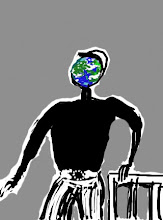Here’s what I mean. Everett’s case starts with two propositions:
(P1) If the world of a story concerns a creature a, and if a is not a real thing, then a is a fictional character.‘The world of the story’ in (P2) puzzles me; I think what Everett is getting at is the question of how, assuming we take fictional characters to be in some sense ‘real’, what we make of different versions of one character—Faustus in Marlowe and Goethe, for instance; or Jekyll/Hyde in Stevenson and Alan Moore. (Is Faust ‘real’ in Marlowe but not in Goethe? Vice versa? ‘Realer’ in one than the other? Surely Romeo is ‘realer’ in Shakespeare’s play than in that Dire Straits song. You can see the sorts of arguments we might have.) So OK; here’s Everett’s thesis:
(P2) If a story concerns a and b, and if a and b are not real things, then a and b are identical in the world of the story iff the fictional character of a is identical to the fictional character of b. [627]
I shall argue, authors may leave certain things unspecified about the world of their story including whether certain creatures count as identical or distinct in that world and which creatures exist in that world. Given (P1) and (P2) this sort of underspecification within a story gives rise to ontic indeterminancy concerning which fictional characters occur within that story. Moreover, I shall argue, if the laws of logic and identity fail in the world of a story, these failures may infect the fictional characters occurring in that story. In short, given (P1) and (P2), the fictional realist seems committed to certain pernicious forms of indeterminancy and to objects that flout the laws of logic and identity. [627-8]He means something technically precise by ‘ontic indeterminancy’, of course; but it isn’t clear to me to what extent ‘laws of logic and identity’ ought or, in fact, do apply to any sort of character, real or fictional. The obvious move here is surely to apply Everettian strategies to the actual world and see how they shake down. Because if the world itself ‘leaves certain things unspecified’, or even exhibits ‘ontic indeterminancy’, then at the very least we can argue that authors creating characters are being true to the nature of things. But it’s hard to avoid the sense that Everett is applying a different argumentative strategy to his ‘fictional characters’ than to the world at large. For instance:
Of course, if we accept fictional characters into our ontology then we face the task of determining precisely which fictional characters there are. [627]Why? Would anybody say ‘of course, if we accept real people into our ontology then we face the task of determining precisely which real people there are’? Or again:
A story might describe an impossible world in which the laws of logic or identity fail. But since by (P1) and (P2), what exists in the world of a story determines which fictional characters occur in that story determines which fictional characters occur in that story, various impossibilities within the world of a story may inflect the fictional characters that occur in that story. [633]He then makes up a story:
When she arrived in Dialethialand, Jane met Jules and Jim. This confused Jane since Jules and Jim both were, and were not, distinct people. And this made it hard to know how to interact with them. For example, since Jules both was and was not Jim, if Jim came to tea Jules both would and wouldn’t come to. [634]I like this story, actually; but it doesn’t show what Everett wants it to show. His case is that, since this world is logically impossible, any ‘characters’ included in it cannot, logically, exist. He concedes that readers are able ‘to engage imaginatively’ with the world of the story (how many biscuits should Jane buy, just enough for Jules, or enough for Jules and Jim? Her solution: ‘both to buy and not to buy extra biscuits whenever Jim came’). ‘I suspect,’ says Everett, ‘that many readers will find Jane's response to the biscuit problem very appropriate, given that she is in Dialethialand’ [635]. But this is a sort of minimal level of imaginative engagement; and as such it misses something huge and crucial about this broader question. It is not that we follow the impossible logic of the story; it is that a story such as this—as with Stevenson’s much more famous Jekyllhydean story about two individuals who both are and are not the same man—resonates as powerfully and eloquently true. Not knowing how to interact with people is a crucial, formative aspect of our being-in-the-world, one that Everett’s little tale addresses directly. Our apperception of people, and our own identity, is not consecutive and logical; and fictional characters are not based upon such alien protocols. We engage imaginatively with Jekyll and Hyde not because it is ‘conceivably possible’ to do so, but because the story, and its characters, are eloquent and powerful and true. Jekyll and Hyde is not false or inconsistent ontology; it is beautifully reflective of our sense of the way actual being-in-the-world is.

No comments:
Post a Comment